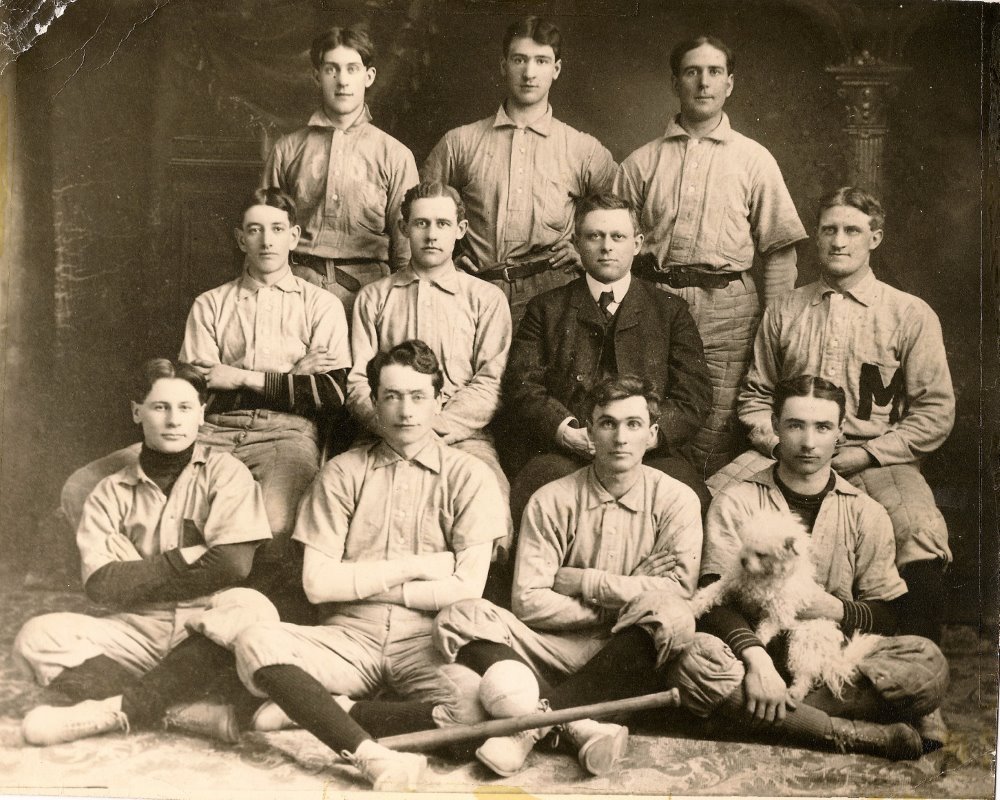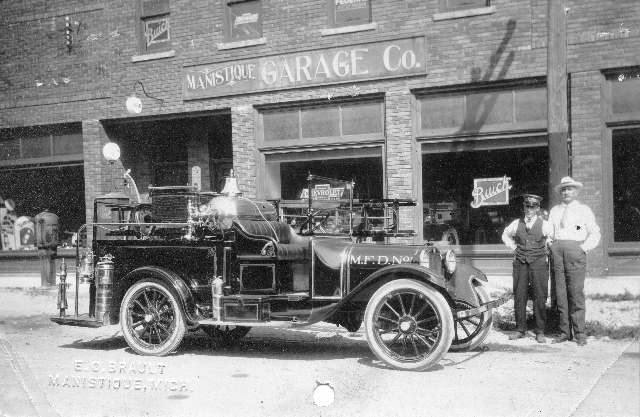
The 1902 Manistique Indoor Baseball Club. Top row from left: Harley Garland, Victor Deemer, John Forshaw. Middle row from left: Dean Crowe, J.C. Wood, Ben Gero, Sr. and Ed Jewell. Bottom row from left: F. Paulson, William S. Crowe, John “Jack” Williams and F. Guinan. Photo courtesy Wm. S. Crowe Collection.
During the early 1900’s, the month of November marked the beginning of the indoor baseball season. Fans flocked to the Star Opera House to watch an indoor version of the national pastime. Season tickets cost a dollar and a quarter. Indoor baseball was invented in the 1880’s and was the forerunner of modern fast-pitch softball. In Manistique, the fraternal societies organized a “city league” which included the Masons, Legionites, Maccabees, Woodmen of the World and the Ancient Order of United Workmen.
Games were played at the Star Opera House located on Maple Street between the Eagle Livery and the Ossawinamakee hotel. The opera house was the venue for a wide variety of social and recreational events including live theatre, lectures, square dances, roller skating and indoor baseball. The unobstructed floor space measured 53 feet by 90 feet.
The rules for indoor baseball varied significantly from the traditional game. The contest began with a coin toss to determine which team would bat first. This took place even when teams visited Manistique from out of town. The winner of the coin toss almost always chose to bat first. The players were also positioned differently. The center fielder position was eliminated, to be replaced by a shortstop on the right side of the diamond. Fly balls hit into the net protecting the crowd in fair territory were scored as doubles. Putouts were made if a ball was caught in the air, even if it had first ricocheted off the ceiling rafters or outfield wall. Any batter who stepped out of the batter’s box was automatically called out.
“City league” play began in November and continued through January. The teams played each other in a round-robin schedule, with the top two teams meeting in a championship game. The teams played for a trophy cup valued at fifty dollars, which was a great deal of money in 1902.
The real fun began in February when the “Manistique Baseball Club,” made up of the best players from the “city league,” tested their skill against teams from other towns. In 1902, the first opponent for the Manistique club was the team from Marquette, nick-named the Beavers, for a two-game set. The Marquette players were confident of an easy victory over the local nine, but they were quickly disabused of that notion. In the first inning Manistique’s star pitcher, William Crowe, struck out the first three men he faced. He went on to record 17 K’s during the game. The Manistique Team scored two runs in the 4th inning and added two more in the 6th, cruising to an 11 to 6 victory.
Manistique’s catcher, Jack Williams, was considered the best all-around baseball player in Upper Michigan. He had a cannon for a throwing arm, cutting down potential base stealers with ease. When an opposing player did reach base, he had difficulty advancing as the Manistique nine usually played errorless baseball.
After Manistique completed the two-game sweep over Marquette with a 9 to 1 triumph, it was Manistique’s opportunity to boast. The writer for the Pioneer Tribune reported that “the hides of nine beavers now adorn the headquarters of the Manistique Indoor Baseball Club.” The games were also a financial success. After deducting all costs including transportation and board for the Marquette players, seventy-four dollars remained to be shared among the two teams.
The Manistique team went on to dominate nearly all comers from across the Upper Peninsula before finally travelling downstate where they were defeated by a team from Detroit. Indoor baseball remained popular through the first decade of the 20th Century, with Manistique winning championships in the years 1902-1907.

Photo of the Manistique Garage Company which was formerly the Star Opera House. It was located on Maple Street where the GM dealership is today.
